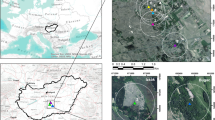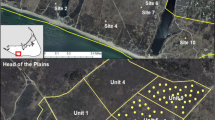Abstract
Barrier islands are exposed to the wind and wave action from storms, which often disturbs both the geomorphology and vegetation. Conservation and restoration efforts for these important habitats could be improved with knowledge of how native plants respond to storms. We analyzed 10 years of annual data of vegetation of St. George Island, Florida, in the Gulf of Mexico, to quantify how the plant community responds to major storms and to predict which dune species might be appropriate for restoration after storm damage across dune zones. This prediction was tested with six plant species that differed in their storm response—from highly negative (local extinction in response to storms) to highly positive (increased abundance in response to storms). We measured transplant survival and growth (plant height and number of shoots) over 2 years in a restoration experiment across three major dune zones. We found that different species can be useful for restoration purposes in different dune zones, depending on both short- and longer-term management strategies. Uniola paniculata is a particularly strong restoration candidate across all dune zones, whereas Muhlenbergia capillaris and Schizachyrium maritimum would be beneficial for restoration in the interdune area. Fimbristylis spp. and Sporobolus virginicus demonstrate the strongest potential for restoration in the interdune and backdune areas. Restoration of disturbed areas often involves the seeding or transplanting of species to stabilize the landscape and initiate the return of the original vegetation. We show that the performance of native species, in response to storms, especially in conjunction with information on plant life history, can be useful for identifying the best species to use for restoration.




Similar content being viewed by others
References
Begum, M., A.S. Juraimi, R. Amartalingam, A.B. Man, and S.O.B.S. Rastans. 2006. The effects of sowing depth and flooding on the emergence, survival, and growth of Fimbristylis miliacea (L.) Vahl. Weed Biology and Management 6: 157–164.
Blits, K.C., and J.L. Gallagher. 1991. Morphological and physiological responses to increased salinity in marsh and dune ecotypes of Sporobolus virginicus (L.) Kunth. Oecologia 87: 330–335.
Borja, Angel, Daniel M. Dauer, Michael Elliott, and Charles A. Simenstad. 2010. Medium- and long-term recovery of estuarine and coastal ecosystems: patterns, rates and restoration effectiveness. Estuaries and Coasts 33: 1249–1260.
Boughey, Arthur S. 1957. Ecological studies of tropical coastlines. I. The Gold Coast, West Africa. Journal of Ecology 45: 665–687.
Bull, J.Scott, Daniel C. Reed, and Sally J. Holbrook. 2004. An experimental evaluation of different methods of restoring Phyllospadix torreyi (surfgrass). Restoration Ecology 12: 70–79.
Burnham, Kenneth P., and David R. Anderson. 2002. Model selection and multimodel inference: a practical information-theoretic approach, 2nd ed. New York: Springer.
Camargo, Jose L.C., Isolde D.K. Ferraz, and Angela M. Imakawa. 2002. Rehabilitation of degraded areas of Central Amazonia using direct sowing of forest tree seeds. Restoration Ecology 10: 636–644.
Chapin, F.Stuart, Kellar Autumn, and Francisco Pugnaire. 1993. Evolution of suites of traits in response to environmental stress. The American Naturalist 142: S78–S92.
Dahl, B. E., B. A. Fall, A. Lohse, S. G. Appan. 1975. Construction and stabilization of coastal foredunes with vegetation: South Padre Island, Texas. MP 9-75, U.S. Army Corps of Engineers, Coastal Engineering Research Center, Fort Belvoir, Virginia.
Dech, Jeffery P., and M. Anwar Maun. 2006. Adventitious root production and plastic resource allocation to biomass determine tolerance in woody plants from Central Canadian coastal dunes. Annals of Botany 98: 1095–1105.
Doing, H. 1985. Coastal fore-dune zonation and succession in various parts of the world. In Ecology of coastal vegetation, ed. G. Wim, Befftink, H.L. Ad, Huiskes, H.L. Ad, and Rozema Jelte, 640. London: Springer.
R Development Core Team. 2007. R: a language and environment for statistical computing. R Foundation for Statistical Computing, Vienna, Austria. http://www.r-project.org.
Ehrenfeld, Joan G. 1990. Dynamics and processes of barrier island vegetation. Aquatic Sciences 2: 437–480.
Fagherazzi, S., P. L. Wiberg, and A. D. Howard. 2003. Modeling barrier island formation and evolution. Coastal Sediments, May 18–23, Clearwater Beach, Florida.
Falk, Donald A., Margaret A. Palmer, Joy B. Zedler, and Richard J. Hobbs. 2006. Foundations of restoration ecology. Washington, DC: Island Press.
Fenster, Michael S., and Bruce P. Hayden. 2007. Ecotone displacement trends on a highly dynamic barrier island: Hog Island, Virginia. Estuaries and Coasts 30: 978–988.
Funk, Jennifer L., Elsa E. Cleland, Katherine N. Suding, and Erika S. Zavaleta. 2008. Restoration through reassembly: plant traits and invasion resistance. Trends in Ecology & Evolution 23: 695–703.
Giardina, Christian P., Creighton M. Litton, Jarrod M. Thaxton, Susan Cordell, Lisa J. Hadway, and Darren R. Sandquist. 2007. Science driven restoration: a candle in a demon haunted world—response to Cabin. Restoration Ecology 15: 171–176.
Gormally, Cara L., and Lisa A. Donovan. 2010. Responses of Uniola paniculata L. (Poaceae), an essential dune-building grass, to complex changing environmental gradients on the coastal dunes. Estuaries and Coasts 33: 1237–1246.
Gornish, Elise S. 2009. Use of long-term vegetation census data to inform restoration methods and processes of community ecology on a barrier island. MS thesis, Florida State University, Tallahassee.
Harper, John L. 1967. A Darwinian approach to plant ecology. Journal of Ecology 55: 247–270.
Hayes, M. O. 1979. Barrier island morphology as a function of tidal and wave regime. In: SP Leatherman (Ed.) Barrier Islands. New York: Academic, pp. 1–28.
Hesp, P.A. 1991. Ecological processes and plant adaptations on coastal dunes. Journal of Arid Environments 21: 165–191.
Johnson, A.F. 1997. Rates of vegetation succession on a coastal dune system in northwest Florida. Journal of Coastal Research 13: 373–384.
Lewis, R.R. 1982. Creation and restoration of coastal plant communities. Boca Raton, FL: CRC.
Miller, D.L., M. Thetford, and M. Schneider. 2008. Distance from the Gulf influences survival and growth of three barrier island dune plants. Journal of Coastal Research 24: 261–266.
Miller, T.E., E.S. Gornish, and H. Buckley. 2010. Climate and coastal dune vegetation: disturbance, recovery, and succession. Plant Ecology 206: 97–104.
Montalvo, A.M., S.L. Williams, K.J. Rice, S.L. Buchmann, C. Cory, S.N. Handel, G.P. Nabhan, R. Primack, and R.H. Robichaux. 1997. Restoration biology: a population biology perspective. Restoration Ecology 5: 277–290.
Moreno-Casasola, P., and I. Espejel. 1986. Classification and ordination of coastal sand dune vegetation along the Gulf and Caribbean Sea of Mexico. Vegetatio 66: 147–182.
Otvos, E.G. 2012. Coastal barriers—nomenclature, process and classification issues. Geomorphology 139–140: 39–52.
Palmer, M.A. 2009. Reforming watershed restoration: science in need of application and applications in need of science. Estuaries and Coasts 32: 1–17.
Palmer, M.A., R.F. Ambrose, and N. LeRoy Poff. 2008. Ecological theory and community restoration ecology. Restoration Ecology 5: 291–300.
Pries, A.J., D.L. Miller, and L.C. Branch. 2008. Identification of structural and spatial features that influence storm-related dune erosion along a barrier-island ecosystem in the Gulf of Mexico. Journal of Coastal Research 24: 168–175.
Rodgers, J., C. John, A.W. Murrah, and W.H. Cooke. 2009. The impact of Hurricane Katrina on the coastal vegetation of the Weeks Bay Reserve, Alabama from NDVI data. Estuaries and Coasts 32: 496–507.
Sarmiento, L., L.D. Llambi, A. Escalona, and N. Marquez. 2003. Vegetation patterns, regeneration rates and divergence in an old-field succession of the high tropical Andes. Plant Ecology 166: 63–74.
Schneider, J.C., and S.E. Kruse. 2006. Assessing selected natural and anthropogenic impacts on freshwater lens morphology on small barrier islands: Dog Island and St. George Island, Florida, USA. Hydrogeology Journal 14: 131–145.
Stallins, J.A., and A.J. Parker. 2003. The influence of complex systems interactions on barrier island dune vegetation pattern and process. Annals of the Association of American Geographers 93: 13–29.
Stalter, R., and W.T. Batson. 1969. Transplantation of salt marsh vegetation, Georgetown, South Carolina. Ecology 50: 1087–1089.
Thom, R.M. 2000. Adaptive management of coastal ecosystem restoration projects. Ecological Engineering 15: 365–372.
Thom, R.M., G.D. Williams, A.D. Borde, J.A. Southward, S.L. Sargeant, D.L. Woodruff, J.C. Laufle, and S. Glasoe. 2005. Adaptively addressing uncertainty in estuarine and near coastal restoration projects. Journal of Coastal Research 40: 94–108.
Viejo, R.M. 2009. Resilience in intertidal rocky shore assemblages across the stress gradient created by emersion times. Marine Ecology Progress Series 390: 55–56.
Wankhar, B., and R.S. Tripathi. 1990. Growth and reproductive allocation pattern of Centella asiatica raised from stem cuttings of different sized in relation to light regimes, soil texture and soil moisture. Acta Oecol. International Journal of Ecology 11: 683–692.
Acknowledgments
Jackie Monge and John Mola contributed to aspects of this work. John Sulik helped create Fig. 1. We are grateful for the help of over 50 volunteers over the years who are too numerous to list here. This work was funded by grants to TEM from the National Oceanic and Atmospheric Administration (NA08NOS4200264) and the National Fish and Wildlife Service (401817G051).
Author information
Authors and Affiliations
Corresponding author
Rights and permissions
About this article
Cite this article
Gornish, E.S., Miller, T.E. Using Long-Term Census Data to Inform Restoration Methods for Coastal Dune Vegetation. Estuaries and Coasts 36, 1014–1023 (2013). https://doi.org/10.1007/s12237-013-9617-0
Received:
Revised:
Accepted:
Published:
Issue Date:
DOI: https://doi.org/10.1007/s12237-013-9617-0




